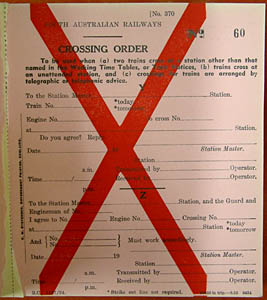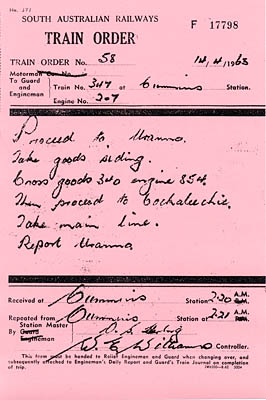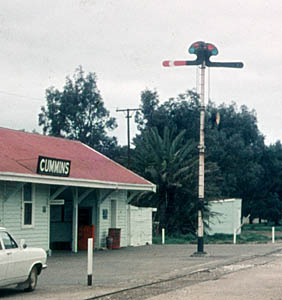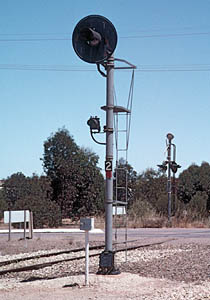

|
This system is similar to the American "Timetable and Train Order" method of safeworking. Trains ran on the authority of published Working Timetables and Train Notices, subject to minimum separation times. If trains were to cross at stations other than as scheduled, then Crossing Orders were issued by the appropriate Station Masters. If a scheduled cross was not to take place, then a Proceed Order would be issued.
Train Record Books were kept at designated stations (most sidings on Eyre Peninsula were designated), and train times were recorded in these. Following movements had to allow the scheduled running time to the next Train Record Book station (to a maximum of 30 minutes) after the previous departure, before entering a section. Permissive Block working is generally suitable only for low traffic levels, and was appropriate in remote areas where communication was difficult or (in some cases) non-existent. The early years of the Port Lincoln Division fitted this description well, with Port Lincoln - Thevenard, Cummins-Buckleboo, Yeelanna-Mount Hope and Wandana-Penong all worked originally under Permissive Block. |

|
|
A sample Crossing Order, in the National Railway Museum archives. |
|
Train Order working was introduced to South Australia by Commissioner Webb in the 1920s. Under this system, a Train Controller with responsibility for a line or group of lines issues Train Orders which are the authority for trains to occupy main lines between stations.
As all movements (including crosses with opposing trains) are authorised by specific orders, it is not necessary for timetabled crossing locations to be adhered to, improving flexibility and efficiency. Separation of trains is ensured by having crews report their progress to Control when so instructed, but in most cases trains no longer had to stop at what had previously been Train Record Book stations. Train Order working replaced Permissive Block between Port Lincoln and Cummins on 13 May 1929. Cummins-Thevenard, Cummins-Buckleboo and Yeelanna-Mount Hope became Train Order territory on 12 Nov 1934, but the Wandana-Penong line was not converted until 13 Feb 1949. The Kowulka-Kevin and Penong Junction-Kevin lines were opened as Train Order territory. The Train Control office at Port Lincoln was closed on 8 Jan 1989, control being transferred to Adelaide from that date. |

|
|
A typical Train Order. This one is for the Kimba/Buckleboo goods (train 347) with loco T207 at Cummins on 14 Apr 1963, and includes a cross with diesel 854 at Uranno.
|
|
The Port Lincoln Division has never had more than a few fixed signals. Port Lincoln itself was provided with an Up Home and an Up Distant on 29 Jan 1923, but they were removed on 24 Oct 1929. Train Order signals were provided at a number of attended stations in the 1930s, but all had been removed by the end of 1984.
|

|
|
The Train Order signal at Cummins in 1970.
|
|
| Three absolute searchlight signals have since been installed - up signal protecting the Eyre Highway level crossing at Kyancutta (installed after the 1992 collision involving NJ2), a down signal at the LeBrun St level crossing at Port Lincoln on 15 May 1986, and an up signal at the Eyre Highway level crossing at Kimba on 29 May 1986. All three are provided to allow shunting without triggering the adjacent level crossing warning signals. |

|
|
Up absolute signal and flashing lights at Kimba, Nov 2002.
|
|
